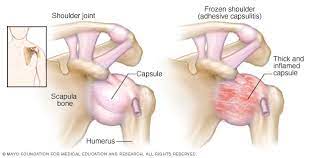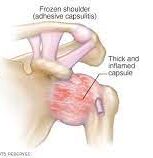What is Frozen Shoulder Pain Like?
To understand the pain associated with frozen shoulder, it is important to understand what frozen shoulder is all about.
Frozen shoulder (Adhesive Capsulitis) is a condition characterized by stiffness and pain in the shoulder joint. The onset of frozen shoulder is often gradual, worsening over time and then resolving within one to two years. Initial symptoms are variable and can range from sharp pain to soreness/achiness at the shoulder and the upper arm. It can be accompanied by difficulty sleeping and difficulty reaching behind back or overhead.

There are four stages to Frozen Shoulder:
- Pre Freezing: This is the initial stage of frozen shoulder where it is difficult to determine if the symptoms you are experiencing are indeed due to frozen shoulder. You can have pain without limitations in motion at the shoulder or slight limitations in motion which can be attributed to tendonitis or bursitis at the shoulder.
- Freezing: This is the second stage of Frozen shoulder. It is accompanied by pain and soreness at the shoulder. You will notice increasing difficulty in reaching overhead, behind your back, pain when sleeping on the shoulder and soreness at the shoulder and upper arm. You gradually see loss of motion at the shoulder that keeps worsening
- Frozen: This is the third stage of the Frozen shoulder where there is very limited motion at the shoulder (the shoulder is “frozen”) but the pain has subsided and it is not as intense as before. Yet movement loss limits ability to do preferred activities.
- Thawing: This is the last Stage of Frozen shoulder. It is accompanied by very little pain and a gradual release of tightness at the shoulder. You will start to see you are gaining your movements back and are able to reach overhead and behind the back again.
Physical therapy is extremely beneficial for Frozen shoulder. It can alleviate pain and help regain motion; restoring function for daily activities. Physical Therapy activities are stage dependent.
In the pre-freezing and the Freezing stage, the focus is on alleviating pain, promoting return of motion, preventing further loss of motion /”Freezing”. Your physical therapist will provide you with exercises to improve your motion which can also be performed at home.
In the frozen stage, your therapist will work with you diligently to restore your motion with specific exercises and manual treatments like joint mobilizations, myofascial releases and manual stretches. The focus is to regain your motion and strength.
In the thawing stage, the focus is to regain full motion and strength at the shoulder. Your physical therapist will find the limited areas of motion and strength and work with you with specific exercises to restore the limitations, normal biomechanics at the shoulder and return to activity of choice.
How Can we Help
At Physis PT and Rehab we will not only assess the shoulder, but will complete a full functional assessment of your activities, examining the neck, back and arms to determine the source of the symptoms. Treatment plan will be determined based on the diagnosis, involving one on one treatment to abolish pain and regain motion to maximize participation in daily and sport activities.

